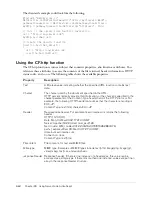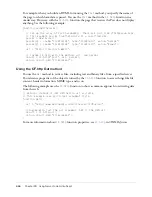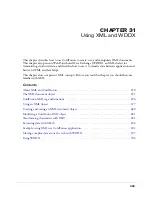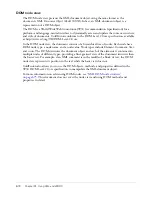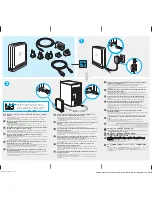
670
Chapter 31: Using XML and WDDX
About XML and ColdFusion
In the last few years, XML has rapidly become the universal language for representing documents
and data on the web. These documents can extend beyond the traditional concept of a paper
document or its equivalent. For example, XML is often used to represent database or directory
information. XML is also commonly used to represent transaction information, such as product
orders or receipts, and for information such as inventory records and employee data.
Because XML represents data in a tagged, textual format it is an excellent tool for representing
information that must be shared between otherwise-independent applications such as order entry
and inventory management. No application needs to know anything about the other. Each
application only needs to be prepared to get data in a format that is structured according to the
XML DTD or Schema. For example, in a distributed order processing application, the order
placement component, order fulfilment component, inventory management component, and
billing component can all share information with each other in XML format. They could use a
common XML DTD, of different components could communicate with each other using
different DTDs.
After an application parses the XML document, it can then manipulate the information in any
way that is appropriate. For example, you can convert tabular XML data into a ColdFusion
recordset, perform queries on the data and then export the data an XML document. For example,
the code in
“Example: using XML in a ColdFusion application” on page 692
takes a customer
order in XML, converts the data to a recordset, and uses a query to determine the order cost. It
then prepares a receipt as an XML document.
ColdFusion provides a comprehensive and easy-to-use set of tools for creating and using XML
documents. ColdFusion lets you do the following with XML documents:
•
Convert XML text into ColdFusion XML document objects.
•
Create new ColdFusion XML document objects.
•
Modify ColdFusion XML document objects.
•
Transform XML using XSLT.
•
Extract data from XML documents using XPath expressions.
•
Convert ColdFusion XML document objects to text and save them in files.
Summary of Contents for ColdFusion MX
Page 1: ...Developing ColdFusion MX Applications...
Page 22: ...22 Contents...
Page 38: ......
Page 52: ...52 Chapter 2 Elements of CFML...
Page 162: ......
Page 218: ...218 Chapter 10 Writing and Calling User Defined Functions...
Page 250: ...250 Chapter 11 Building and Using ColdFusion Components...
Page 264: ...264 Chapter 12 Building Custom CFXAPI Tags...
Page 266: ......
Page 314: ...314 Chapter 14 Handling Errors...
Page 344: ...344 Chapter 15 Using Persistent Data and Locking...
Page 349: ...About user security 349...
Page 357: ...Security scenarios 357...
Page 370: ...370 Chapter 16 Securing Applications...
Page 388: ...388 Chapter 17 Developing Globalized Applications...
Page 408: ...408 Chapter 18 Debugging and Troubleshooting Applications...
Page 410: ......
Page 426: ...426 Chapter 19 Introduction to Databases and SQL...
Page 476: ...476 Chapter 22 Using Query of Queries...
Page 534: ...534 Chapter 24 Building a Search Interface...
Page 556: ...556 Chapter 25 Using Verity Search Expressions...
Page 558: ......
Page 582: ...582 Chapter 26 Retrieving and Formatting Data...
Page 668: ......
Page 734: ...734 Chapter 32 Using Web Services...
Page 760: ...760 Chapter 33 Integrating J2EE and Java Elements in CFML Applications...
Page 786: ...786 Chapter 34 Integrating COM and CORBA Objects in CFML Applications...
Page 788: ......









